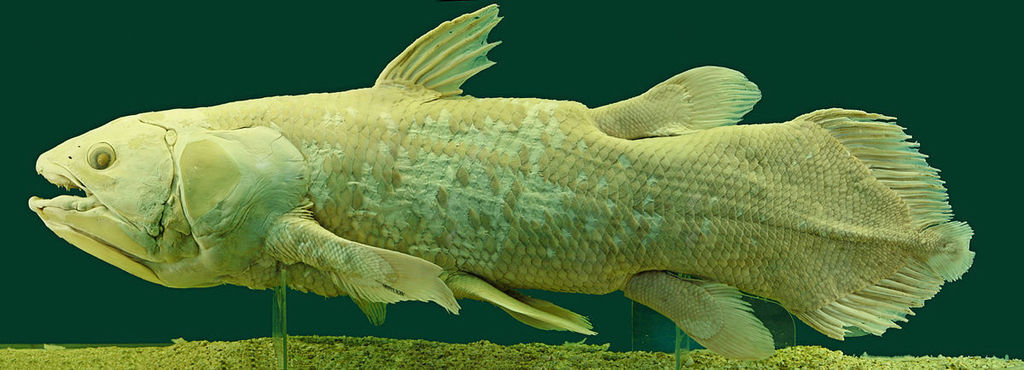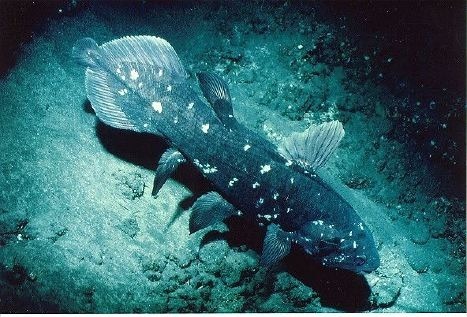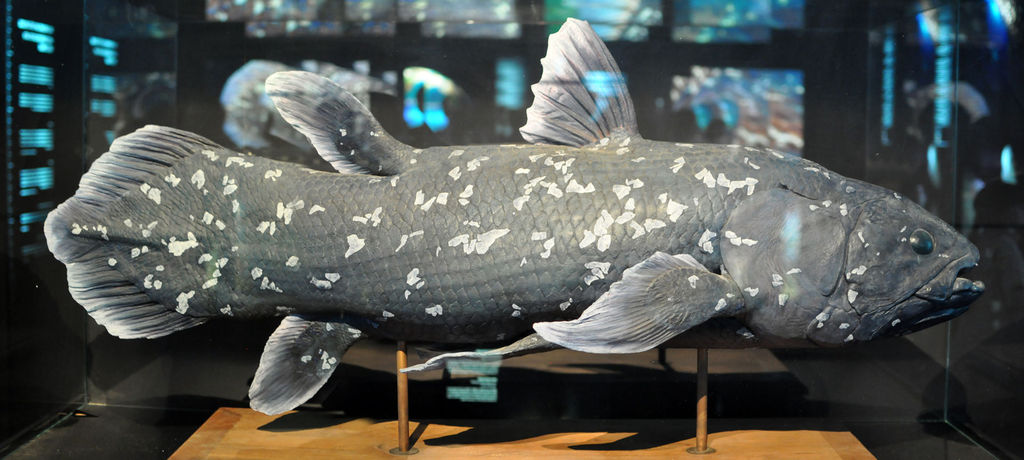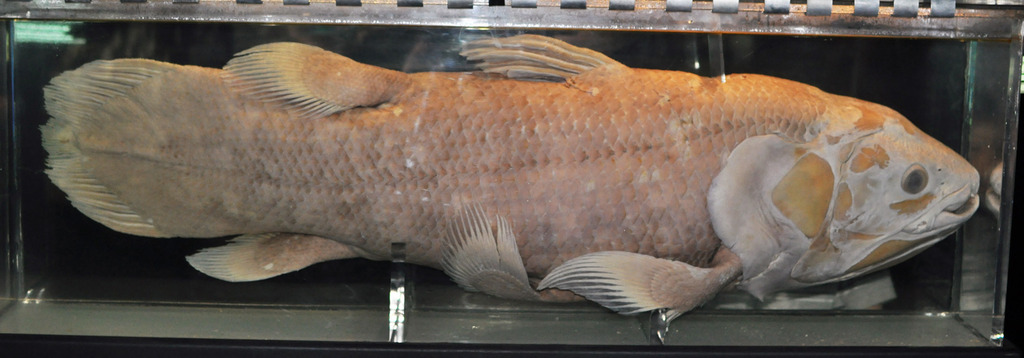2017年08月23日
5 Bizarre Facts About the Coelacanth | What the Stuff?!
5 Bizarre Facts About the Coelacanth | What the Stuff?!
https://youtu.be/3LXRzvP0D_0
5 Bizarre Facts About the Coelacanth
| What the Stuff?!
https://youtu.be/3LXRzvP0D_0
Published on Nov 21, 2015
The coelacanth is an order of bottom-dwelling, carnivorous ocean fish that grow up to 6 and a half feet (2 meters) long and weigh up to 200 pounds (91 kilograms). But they’re not just huge and crazy ugly – they’re also one of the most interesting animals in all of biology.
Coelacanth Article:
http://animals.howstuffworks.com/enda...
Subscribe http://bit.ly/1AWgeM7
Twitter https://twitter.com/HowStuffWorks
Facebook https://www.facebook.com/HowStuffWorks
Google+ https://plus.google.com/+howstuffworks
Website http://www.howstuffworks.com
Watch More https://www.youtube.com/HowStuffWorks
Music:
"Venus" by Jahzzar
Video Attribution:
FOSSIL FISH FOUND ALIVE ( diving with dinosaur fish )
https://www.youtube.com/watch?v=v8hug...
Transcript:
The coelacanth (SEEL-uh-kanth) is an order of bottom-dwelling, carnivorous ocean fish that grow up to 6 and a half feet (2 meters) long and weigh up to 200 pounds (91 kilograms). But they’re not just huge and crazy ugly – they’re also one of the most interesting animals in all of biology.
People used to think coelacanths were extinct. Imagine if tomorrow scientists discovered that a small herd of triceratops were still alive, living somewhere in the rain forests of South America. Well, trade that genus of dinosaur for an order of lobe-finned fish, and that’s pretty much what happened with the coelacanth. Up until the 1930s, scientists only knew about the coelacanth from the fossil record -- everyone thought that these fish had been extinct for about 65 million years! But in December 1938, a South African museum curator named Marjorie Courtenay-Latimer got a call from a fishing fleet manager asking if she wanted to take a look at a selection of fish caught near the mouth of the Chalumna River off the coast of South Africa. When Courtenay-Latimer examined the haul, she found a strange, 5-foot-long, blue-gray fish with fins that resembled legs. Together, Courtenay-Latimer and a nearby chemistry professor and amateur ichthyologist named J.L.B. Smith worked to identify the newly discovered fish, and realized that the order of Coelacanth had survived -- unrecognized, unappreciated and unloved -- into the present day. Today there are only two known species of coelacanth left alive: the Latimeria menadoensis and Latimeria chalumnae – both get their genus name from Courtenay-Latimer. No one knows exactly how many specimens of each species are left on Earth, but scientists consider both to be rare and threatened.
They’re cave-dwellers. The known coelacanth populations left alive today can usually be found near caves around deep, rocky areas off the coast of volcanic islands. During the daytime, they usually hide inside the caves. At night, they emerge to hunt ... which they do by passively floating in the water, waiting for favorite snacks like squid and octopus to drift by.
Coelacanths have tiny brains. The brain of an adult coelacanth takes up less than 1.5 percent of its cranial cavity; the other 98.5 percent of the cavity is literally just full of fat. You can chalk this up to something called “negative allometric growth” – when an organ doesn’t grow as fast as the rest of the body. When a coelacanth is young, its brain takes up much more of the cranial cavity. But as the fish grows bigger, the brain doesn’t grow proportionally – the skull keeps getting bigger, but the brain doesn’t.
They’re unique among living fish. Unlike any other living fish species, coelacanths have a special “intracranial joint” that works like a “hinge” for the anterior portion of their skulls. Together with a muscle underneath the upper jaw known as the basicranial muscle, this hinge helps the coelacanth generate a stronger bite force. They also have a unique “rostral organ” in the nose, which they use as part of their electrosensory system.
Coelacanth meat is disgusting and will make you sick. Have you ever been curious to taste the meat of an endangered ancient animal? Sure, we all have, but let us insist: You do not want to eat a coelacanth. Its meat has been described as slimy, oily and mucus-covered, with a foul smell -- not unlike the stuff in my college fridge. Even better, Coelacanth flesh is full of urea, which is a nitrogen-based compound that your kidneys cleanse from your blood and you then excrete in your pee. So it’s kind of like eating greasy urine-flesh. But it’s also full of wax esters, which are molecules of indigestible junk that your body will probably discharge in a flood of unstoppable oily diarrhea. Local fish-catchers call it “Gombessa,” meaning “taboo” – suggesting there’s cultural knowledge that this fish is not good for eating. So if Captain D’s jumps on the irony-based food bandwagon and launches an ad campaign for a double-fried coelacanth taco or whatever... consider yourself warned.
Category Education
License Standard YouTube License
=======================
NOTE
シーラカンス Coelacanth
https://en.wikipedia.org/wiki/Coelacanth#/media/File:Latimeria_Chalumnae_-_Coelacanth_-_NHMW.jpg


シーラカンス:Wikipedia
https://en.wikipedia.org/wiki/Coelacanth#/media/File:Latimeria_Chalumnae_-_Coelacanth_-_NHMW.jpg
https://ja.wikipedia.org/wiki/%E3%82%B7%E3%83%BC%E3%83%A9%E3%82%AB%E3%83%B3%E3%82%B9
Coelacanth:Wikipedia
https://en.wikipedia.org/wiki/Coelacanth
West Indian Ocean coelacanth:Wikipedia
https://en.wikipedia.org/wiki/West_Indian_Ocean_coelacanth
https://en.wikipedia.org/wiki/Coelacanth#/media/File:Latimeria_chalumnae_replica.jpg

Coelacanth (Latimeria chalumnae) caught on 21 January 1965, next to Mutsamudu (Anjouan, Comoro Islands).C36
https://en.wikipedia.org/wiki/West_Indian_Ocean_coelacanth#/media/File:Latimeria_chalumnae.jpg

===================================================
===================================================


===================================================
===================================================
https://youtu.be/3LXRzvP0D_0
5 Bizarre Facts About the Coelacanth
| What the Stuff?!
https://youtu.be/3LXRzvP0D_0
Published on Nov 21, 2015
The coelacanth is an order of bottom-dwelling, carnivorous ocean fish that grow up to 6 and a half feet (2 meters) long and weigh up to 200 pounds (91 kilograms). But they’re not just huge and crazy ugly – they’re also one of the most interesting animals in all of biology.
Coelacanth Article:
http://animals.howstuffworks.com/enda...
Subscribe http://bit.ly/1AWgeM7
Twitter https://twitter.com/HowStuffWorks
Facebook https://www.facebook.com/HowStuffWorks
Google+ https://plus.google.com/+howstuffworks
Website http://www.howstuffworks.com
Watch More https://www.youtube.com/HowStuffWorks
Music:
"Venus" by Jahzzar
Video Attribution:
FOSSIL FISH FOUND ALIVE ( diving with dinosaur fish )
https://www.youtube.com/watch?v=v8hug...
Transcript:
The coelacanth (SEEL-uh-kanth) is an order of bottom-dwelling, carnivorous ocean fish that grow up to 6 and a half feet (2 meters) long and weigh up to 200 pounds (91 kilograms). But they’re not just huge and crazy ugly – they’re also one of the most interesting animals in all of biology.
People used to think coelacanths were extinct. Imagine if tomorrow scientists discovered that a small herd of triceratops were still alive, living somewhere in the rain forests of South America. Well, trade that genus of dinosaur for an order of lobe-finned fish, and that’s pretty much what happened with the coelacanth. Up until the 1930s, scientists only knew about the coelacanth from the fossil record -- everyone thought that these fish had been extinct for about 65 million years! But in December 1938, a South African museum curator named Marjorie Courtenay-Latimer got a call from a fishing fleet manager asking if she wanted to take a look at a selection of fish caught near the mouth of the Chalumna River off the coast of South Africa. When Courtenay-Latimer examined the haul, she found a strange, 5-foot-long, blue-gray fish with fins that resembled legs. Together, Courtenay-Latimer and a nearby chemistry professor and amateur ichthyologist named J.L.B. Smith worked to identify the newly discovered fish, and realized that the order of Coelacanth had survived -- unrecognized, unappreciated and unloved -- into the present day. Today there are only two known species of coelacanth left alive: the Latimeria menadoensis and Latimeria chalumnae – both get their genus name from Courtenay-Latimer. No one knows exactly how many specimens of each species are left on Earth, but scientists consider both to be rare and threatened.
They’re cave-dwellers. The known coelacanth populations left alive today can usually be found near caves around deep, rocky areas off the coast of volcanic islands. During the daytime, they usually hide inside the caves. At night, they emerge to hunt ... which they do by passively floating in the water, waiting for favorite snacks like squid and octopus to drift by.
Coelacanths have tiny brains. The brain of an adult coelacanth takes up less than 1.5 percent of its cranial cavity; the other 98.5 percent of the cavity is literally just full of fat. You can chalk this up to something called “negative allometric growth” – when an organ doesn’t grow as fast as the rest of the body. When a coelacanth is young, its brain takes up much more of the cranial cavity. But as the fish grows bigger, the brain doesn’t grow proportionally – the skull keeps getting bigger, but the brain doesn’t.
They’re unique among living fish. Unlike any other living fish species, coelacanths have a special “intracranial joint” that works like a “hinge” for the anterior portion of their skulls. Together with a muscle underneath the upper jaw known as the basicranial muscle, this hinge helps the coelacanth generate a stronger bite force. They also have a unique “rostral organ” in the nose, which they use as part of their electrosensory system.
Coelacanth meat is disgusting and will make you sick. Have you ever been curious to taste the meat of an endangered ancient animal? Sure, we all have, but let us insist: You do not want to eat a coelacanth. Its meat has been described as slimy, oily and mucus-covered, with a foul smell -- not unlike the stuff in my college fridge. Even better, Coelacanth flesh is full of urea, which is a nitrogen-based compound that your kidneys cleanse from your blood and you then excrete in your pee. So it’s kind of like eating greasy urine-flesh. But it’s also full of wax esters, which are molecules of indigestible junk that your body will probably discharge in a flood of unstoppable oily diarrhea. Local fish-catchers call it “Gombessa,” meaning “taboo” – suggesting there’s cultural knowledge that this fish is not good for eating. So if Captain D’s jumps on the irony-based food bandwagon and launches an ad campaign for a double-fried coelacanth taco or whatever... consider yourself warned.
Category Education
License Standard YouTube License
=======================
NOTE
シーラカンス Coelacanth
https://en.wikipedia.org/wiki/Coelacanth#/media/File:Latimeria_Chalumnae_-_Coelacanth_-_NHMW.jpg


シーラカンス:Wikipedia
https://en.wikipedia.org/wiki/Coelacanth#/media/File:Latimeria_Chalumnae_-_Coelacanth_-_NHMW.jpg
https://ja.wikipedia.org/wiki/%E3%82%B7%E3%83%BC%E3%83%A9%E3%82%AB%E3%83%B3%E3%82%B9
Coelacanth:Wikipedia
https://en.wikipedia.org/wiki/Coelacanth
West Indian Ocean coelacanth:Wikipedia
https://en.wikipedia.org/wiki/West_Indian_Ocean_coelacanth
https://en.wikipedia.org/wiki/Coelacanth#/media/File:Latimeria_chalumnae_replica.jpg

Coelacanth (Latimeria chalumnae) caught on 21 January 1965, next to Mutsamudu (Anjouan, Comoro Islands).C36
https://en.wikipedia.org/wiki/West_Indian_Ocean_coelacanth#/media/File:Latimeria_chalumnae.jpg

===================================================
===================================================
===================================================
===================================================
【このカテゴリーの最新記事】
-
no image
この記事へのコメント
コメントを書く


